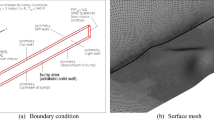Abstract
Turbulent impinging air flow is investigated numerically by using the ANSYS-CFX® code. All computations are performed by considering three-dimensional, steady, and incompressible flow. Three different Reynolds averaged Navier–Stokes (RANS) turbulence models and two Reynolds stress models (RSM’s) are employed. Furthermore three different laminar to turbulent transition (LTT) models are employed with the shear stress transport (SST) and the baseline (BSL) models. Results show that predictions of the SST and two RSM’s are very close each other and these models’ results are in better agreement with the experimental data when all Reynolds numbers used in this study are considered. Secondary maxima in Nusselt number can be seen only if the LTT formula is employed with SST and BSL models.







Similar content being viewed by others
Abbreviations
- D:
-
Jet diameter (m)
- ε:
-
Turbulent dissipation rate (m2/s3)
- h:
-
Convective heat transfer coefficient (W/m2 K)
- k:
-
Turbulence kinetic energy (m2/s2)
- λ:
-
Thermal conductivity (W/mK)
- µ:
-
Dynamic viscosity (kg m/s)
- µt :
-
Turbulent viscosity
- Nux :
-
Local Nusselt number (=hD/λ)
- P:
-
Pressure (Pa)
- Re:
-
Reynolds number (=UD/ν)
- ρ:
-
Density (kg/m3)
- τ:
-
Shear stress (N/m2)
- T:
-
Temperature (K)
- Tu:
-
Inlet turbulence intensity
- x:
-
Distance from stagnation point (m)
- ν:
-
Kinematic viscosity (m2/s)
- ω:
-
Specific dissipation rate (s−1)
- z:
-
Distance between jet and surface (m)
References
Pulat E, Isman MK, Etemoglu AB, Can M (2011) Effect of turbulence models and near-wall modeling approaches on numerical results in impingement heat transfer. Numer Heat Transf Part B Fundam 60:486–519. doi:10.1080/10407790.2011.630956
Hofmann HM, Kaiser R, Kind M, Martin H (2007) Calculations of steady and pulsating impinging jets—an assessment of 13 widely used turbulence models. Numer Heat Transf Part B Fundam 51:565–583. doi:10.1080/10407790701227328
Craft TJ, Graham LJW, Launder BE (1993) Impinging jet studies for turbulence model assessment—II. An examination of the performance of four turbulence models. Int J Heat Mass Transf 36:2685–2697. doi:10.1016/S0017-9310(05)80205-4
Angioletti M, Nino E, Ruocco G (2005) CFD turbulent modelling of jet impingement and its validation by particle image velocimetry and mass transfer measurements. Int J Therm Sci 44:349–356. doi:10.1016/j.ijthermalsci.2004.11.010
Isman MK, Pulat E, Etemoglu a b, Can M (2008) Numerical investigation of turbulent impinging jet cooling of a constant heat flux surface. Numer Heat Transf Part A Appl 53:1109–1132. doi:10.1080/10407780701790078
Bazdidi-Tehrani F, Karami M, Jahromi M (2011) Unsteady flow and heat transfer analysis of an impinging synthetic jet. Heat Mass Transf 47:1363–1373. doi:10.1007/s00231-011-0801-0
Ashok Kumar M, Prasad BVSSS (2011) Computational flow and heat transfer of multiple circular jets impinging on a flat surface with effusion. Heat Mass Transf und Stoffuebertragung 47:1121–1132. doi:10.1007/s00231-011-0776-x
Xu P, Yu B, Qiu S et al (2010) Turbulent impinging jet heat transfer enhancement due to intermittent pulsation. Int J Therm Sci 49:1247–1252. doi:10.1016/j.ijthermalsci.2010.01.020
Xu P, Mujumdar AS, Poh HJ, Yu B (2010) Heat transfer under a pulsed slot turbulent impinging jet at large temperature differences. Therm Sci 14:271–281. doi:10.2298/TSCI1001271X
Xu P, Qiu S, Yu M et al (2012) A study on the heat and mass transfer properties of multiple pulsating impinging jets. Int Commun Heat Mass Transf 39:378–382. doi:10.1016/j.icheatmasstransfer.2012.01.001
Jiang Y, Xu P, Mujumdar AS et al (2012) A numerical study on the convective heat transfer characteristics of pulsed impingement drying. Dry Technol 30:1056–1061. doi:10.1080/07373937.2012.683121
Qiu S, Xu P, Qiao X, Mujumdar AS (2013) Flow and mixing characteristics of pulsed confined opposed jets in turbulent flow regime. Heat Mass Transf und Stoffuebertragung 49:277–284. doi:10.1007/s00231-012-1092-9
Isman MK (2011) Experimental and theoretical investigation of convective heat and mass transfer in single and multiple impinging air jets. Ph.D Thesis. Uludag University, Bursa, Turkey
Hofmann HM, Movileanu DL, Kind M, Martin H (2007) Influence of a pulsation on heat transfer and flow structure in submerged impinging jets. Int J Heat Mass Transf 50:3638–3648. doi:10.1016/j.ijheatmasstransfer.2007.02.001
Hofmann HM, Kind M, Martin H (2007) Measurements on steady state heat transfer and flow structure and new correlations for heat and mass transfer in submerged impinging jets. Int J Heat Mass Transf 50:3957–3965. doi:10.1016/j.ijheatmasstransfer.2007.01.023
Launder BE, Spalding DB (1972) Lectures in mathematical models of turbulence. Academic Press, London
FLUENT (2006) Fluent User’s Guide. Fluent Inc., Lebanon
ANSYS-CFX (2009) ANSYS-CFX solver theory guide. ANSYS Inc., Canonsburg
Salamah S, Kaminski DA (2005) Modeling of turbulent heat transfer from an array of submerged jets impinging on a solid surface. Numer Heat Transf Part A Appl 48:315–337. doi:10.1080/10407780590945551
Morris GK, Garimella SV, Amano RS (1996) Prediction of jet impingement heat transfer using a hybrid wall treatment with different turbulent prandtl number functions. J Heat Transfer 118:562. doi:10.1115/1.2822668
Shi Y, Ray MB, Mujumdar AS (2002) Computational study of impingement heat transfer under a turbulent slot jet. Ind Eng Chem Res 41:4643–4651. doi:10.1021/ie020120a
Hofmann H, Martin H, Kind M (2004) Numerical Simulation of heat transfer from an impinging jet to a flat plate. Chem Eng Technol 27:27–30. doi:10.1002/ceat.200403049
Dutta R, Dewan A, Srinivasan B (2013) Comparison of various integration to wall (ITW) RANS models for predicting turbulent slot jet impingement heat transfer. Int J Heat Mass Transf 65:750–764. doi:10.1016/j.ijheatmasstransfer.2013.06.056
Author information
Authors and Affiliations
Corresponding author
Rights and permissions
About this article
Cite this article
Isman, M.K., Morris, P.J. & Can, M. Investigation of laminar to turbulent transition phenomena effects on impingement heat transfer. Heat Mass Transfer 52, 2027–2036 (2016). https://doi.org/10.1007/s00231-015-1719-8
Received:
Accepted:
Published:
Issue Date:
DOI: https://doi.org/10.1007/s00231-015-1719-8




